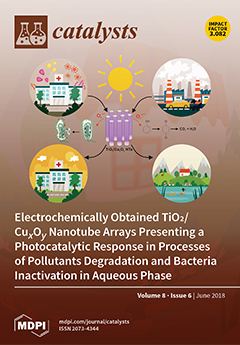Localized surface plasmon resonance (LSPR) plays a significant role in the fields of photocatalysis and solar cells. It can not only broaden the spectral response range of materials, but also improve the separation probability of photo-generated electron-hole pairs through local field enhancement or hot electron injection. In this article, the LSPR effects of Au/TiO
2 composite photocatalyst, with different sizes and shapes, have been simulated by the finite difference time domain (FDTD) method. The variation tendency of the resonance-absorption peaks and the intensity of enhanced local enhanced electric field were systematically compared and emphasized. When the location of Au nanosphere is gradually immersed into the TiO
2 substrate, the local enhanced electric field of the boundary is gradually enhanced. When Au nanoshperes are covered by TiO
2 at 100 nm depths, the local enhanced electric field intensities reach the maximum value. However, when Au nanorods are loaded on the surface of the TiO
2 substrate, the intensity of the corresponding enhanced local enhanced electric field is the maximum. Au nanospheres produce two strong absorption peaks in the visible light region, which are induced by the LSPR effect and interband transitions between Au nanoparticles and the TiO
2 substrate. For the LSPR resonance-absorption peaks, the corresponding position is red-shifted by about 100 nm, as the location of Au nanospheres are gradually immersed into the TiO
2 substrate. On the other hand, the size change of the Au nanorods do not lead to a similar variation of the LSPR resonance-absorption peaks, except to change the length-diameter ratio. Meanwhile, the LSPR effects are obviously interfered with by the interband transitions between the Au nanorods and TiO
2 substrate. At the end of this article, three photo-generated carrier separation mechanisms are proposed. Among them, the existence of direct electron transfer between Au nanoparticles and the TiO
2 substrate leads to the enhanced local enhanced electric field at the boundaries, which is favorable for the improvement of photocatalytic performance of TiO
2. These findings could explain the underlying mechanism of some experimental observations in published experimental works, and helpful to design highly efficient composite photocatalysts that contain noble metal co-catalyst nanoparticles.
Full article





